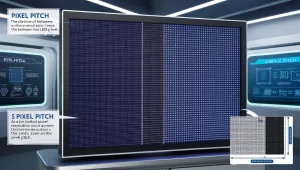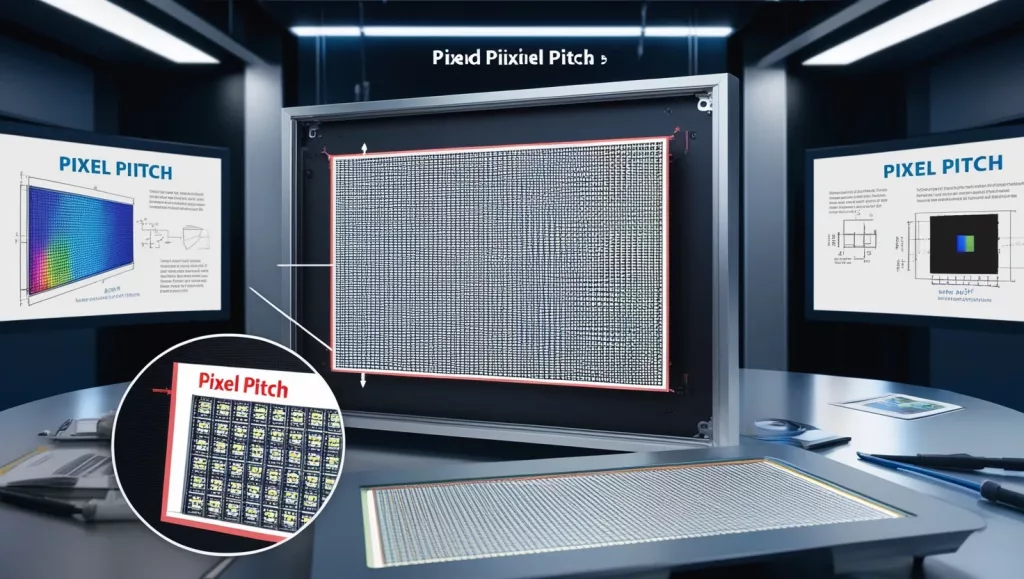Understanding Pixel Pitch in SMD Screens and Why It Matters

When selecting an SMD screen, one of the most critical factors to consider is pixel pitch. While terms like resolution and brightness are often discussed, SMD screen pixel pitch plays an equally vital role in determining the quality of your display. It directly affects how clear your visuals are, how well they are seen from different distances, and how appropriate the screen is for your specific environment. In this article, we’ll break down everything you need to know about pixel pitch and why it matters for high-definition LED screens.
What Is Pixel Pitch?
Pixel pitch refers to the distance between the centers of two adjacent pixels on an LED screen. It’s measured in millimeters (mm), and the smaller the number, the closer together the pixels are. Essentially, pixel pitch determines how tightly packed the pixels are, which impacts the sharpness and clarity of the image displayed.
SMD Screen Pixel Pitch: What You Need to Know
In SMD (Surface-Mounted Diode) screens, the pixel pitch is a critical component of image quality. Smaller pixel pitches mean higher pixel density, leading to sharper, more detailed visuals. Conversely, larger pixel pitches are better suited for displays meant to be viewed from further away, such as outdoor billboards. Therefore, choosing the right SMD screen pixel pitch ensures that your screen delivers optimal performance based on its intended use.
Why Pixel Pitch Matters in SMD Screens
The pixel pitch of an SMD screen has a direct impact on the display’s overall performance. It influences several aspects, including:
- Viewing distance: A smaller pixel pitch is crucial for screens that will be viewed up close, as it provides finer details and smoother images. On the other hand, a larger pixel pitch works well for displays viewed from greater distances.
- Image quality: The closer the pixels, the clearer and crisper the image. High pixel density is essential for displaying complex visuals or detailed graphics, especially on high-definition LED screens.
Pixel Pitch Guide for Different Applications
The ideal pixel pitch depends largely on the specific application and environment. Here’s a quick pixel pitch guide for different types of displays:
- Outdoor displays: Typically, outdoor displays like billboards need a larger pixel pitch (usually between 6mm and 10mm or more), as they are viewed from far distances.
- Indoor displays: Indoor displays, especially those intended for close-up viewing, benefit from smaller pixel pitches (ranging from 1mm to 4mm). This ensures detailed and sharp visuals.
High-Definition LED Screens and Pixel Pitch
For high-definition LED screens, pixel pitch is the key to achieving the sharp, lifelike visuals we associate with HD displays. The higher the pixel density, the better the resolution, especially for larger screens. However, it’s important to strike a balance between pixel pitch and screen size to avoid unnecessary costs or underutilizing the display’s potential.
Choosing the Right Pixel Pitch for Your SMD Screen
Choosing the right pixel pitch requires understanding your viewing environment and audience. For example, if you’re placing a screen in a mall where people pass by at close range, a smaller pixel pitch is ideal. But for a highway billboard, a larger pixel pitch will suffice as the viewing distance is much greater.
Factors to Consider
- Screen size: Larger screens often benefit from a larger pixel pitch since the viewing distance compensates for lower pixel density.
- Viewing distance: Shorter viewing distances demand smaller pixel pitches for sharper images.
SMD Screens for Large-Scale Displays
When it comes to large-scale outdoor displays like digital billboards or stadium screens, pixel pitch plays a crucial role in maintaining clarity. Since these screens are meant to be viewed from a distance, they typically use larger pixel pitches (6mm or higher) to create a balance between screen size and visibility.
SMD Screen Pixel Pitch for Indoor Displays
Indoor displays, like those found in retail stores, museums, or airports, often need a much finer pixel pitch. When the audience is close to the screen, even the smallest pixel gaps become noticeable. For these types of displays, pixel pitches as low as 1mm to 3mm are ideal, offering high clarity and detail even up close.
The Relationship Between Pixel Pitch and Screen Resolution
Pixel pitch directly influences screen resolution, which is the number of pixels that make up the screen’s image. A smaller pixel pitch means more pixels per inch (PPI), leading to higher resolution and sharper images. However, it’s essential to align the pixel pitch with the screen size and viewing distance to optimize the display’s performance.
Understanding Viewing Distance and Pixel Pitch
The closer your audience is to the display, the smaller the pixel pitch should be. For example:
- Short viewing distances (1-2 meters): A pixel pitch of 1mm to 2mm is recommended for crystal-clear details.
- Medium viewing distances (3-6 meters): A 2mm to 4mm pixel pitch offers a good balance of resolution and cost-efficiency.
- Long viewing distances (6 meters and beyond): A pixel pitch of 6mm or larger works well for billboards and outdoor advertising.
Benefits of Low Pixel Pitch in SMD Screens
Low pixel pitch screens deliver the finest details, making them ideal for applications where image quality is paramount. They are perfect for indoor displays, close-up advertising, and spaces that require high-definition visuals. These screens provide smooth transitions, sharper text, and vivid imagery that stands out in any environment.
Common Misconceptions About Pixel Pitch
One common misconception is that smaller pixel pitch is always better. While smaller pixel pitches provide greater detail, they are not always necessary for every application. In fact, using a smaller pixel pitch for a display that will be viewed from a long distance can be overkill, unnecessarily increasing costs without added benefits.
SMDLED: Providing the Best Pixel Pitch Solutions in Pakistan
If you’re looking for the perfect SMD screen pixel pitch for your display, SMDLED is the leading provider in Pakistan. Offering a wide range of high-definition LED screens tailored to meet your specific needs, SMDLED ensures that businesses across the country—from Karachi to Lahore to Islamabad—receive top-quality products that elevate their marketing efforts. Whether you’re looking for indoor or outdoor displays, SMDLED has the right solution. Explore their Products Page or learn more about their technology from their Manufacturer Page.
Conclusion
In conclusion, pixel pitch is a critical factor in determining the quality and effectiveness of your SMD screen. Whether you’re looking to install a massive outdoor billboard or a close-up indoor display, understanding how SMD screen pixel pitch impacts viewing distance, resolution, and clarity will help you make the best decision for your advertising needs.
FAQs
- What is the ideal pixel pitch for outdoor displays?
For outdoor displays, a pixel pitch between 6mm and 10mm is usually ideal for visibility at longer distances. - How does pixel pitch affect viewing distance?
The smaller the pixel pitch, the closer the display can be viewed while maintaining clarity. - Are high-definition LED screens always better with lower pixel pitch?
Not necessarily. Lower pixel pitch is best for close viewing, while larger screens meant for distant viewing can have larger pixel pitch. - Can pixel pitch affect the cost of an SMD screen?
Yes, smaller pixel pitch screens are more expensive due to higher pixel density, but they offer better image clarity. - What’s the difference between pixel pitch and resolution?
Pixel pitch refers to the distance between pixels, while resolution is the total number of pixels on the screen. Both impact image quality.
Looking for premium SMD screens and professional display solutions? SMDLED.PK is your trusted partner for state-of-the-art SMD technology. Explore our top-quality products like the stunning Leyard HDR 4K SMD Video Wall for crystal-clear visuals, the versatile MSA Plus SMD LED Screen Module, the sleek MSA Ultra Thin SMD LED Screen Module for modern setups, the durable MSG Outdoor SMD LED Screen Module, and the efficient MSG Indoor SMD LED Screen Module perfect for indoor environments.
We also offer exceptional Outdoor SMD Screens, Indoor SMD Screens, Flexible SMD Screens for creative designs, Cabinet SMD Screens for secure setups, Signpole SMD Screens for advertising, and stunning SMD Video Walls for large-scale visual impact. With SMDLED.PK, experience reliability, superior technology, and tailored solutions for all your display needs. Visit us today and transform your spaces with unparalleled visual excellence!

